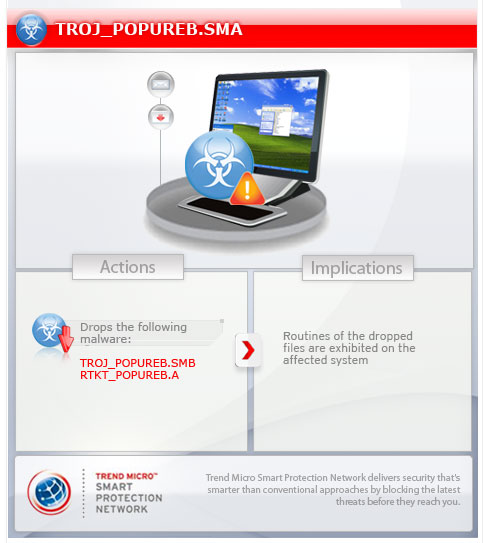TROJ_POPUREB.SMA
Trojan.Gen (Symantec); Trojan:Win32/Popureb.E (Microsoft); Backdoor.Win32.Phanta.ar (Kaspersky); Generic BackDoor!dij (Mcafee); Mal/Generic-L (Sophos)
Windows 2000, Windows XP, Windows Server 2003


Threat Type: Trojan
Destructiveness: No
Encrypted: No
In the wild: Yes
OVERVIEW
This malware uses complex routines to hide in the infected system's master boot record (MBR) in order to evade detection.
To get a one-glance comprehensive view of the behavior of this Trojan, refer to the Threat Diagram shown below.

This Trojan creates a service for its dropped file. It executes its dropped files. As a result, malicious routines of the dropped file are exhibited on the affected system.
It deletes its dropped file after it executes.
It writes its code in the Master Boot Record (MBR). This routine enables it to start even before the operating system is loaded. As well, it also writes the abovementioned components in the MBR.
This Trojan arrives on a system as a file dropped by other malware or as a file downloaded unknowingly by users when visiting malicious sites.
TECHNICAL DETAILS
84,992 bytes
EXE
No
28 Jun 2011
Arrival Details
This Trojan arrives on a system as a file dropped by other malware or as a file downloaded unknowingly by users when visiting malicious sites.
Installation
This Trojan drops and executes the following files:
- %System Root%\alg.exe - detected as TROJ_POPUREB.SMB
- %Current%\hello_tt.sys - detected as RTKT_POPUREB.A
(Note: %System Root% is the root folder, which is usually C:\. It is also where the operating system is located.)
NOTES:
It creates a service for its dropped file. It executes its dropped files. As a result, malicious routines of the dropped file are exhibited on the affected system.
It deletes its dropped file, %Current%\hello_tt.sys, after execution.
It writes its code in the Master Boot Record (MBR). This routine enables it to start even before the operating system is loaded. As well, it also writes the abovementioned components, HELLO_TT.SYS and ALG.EXE, in the MBR.
SOLUTION
8.900
8.254.04
28 Jun 2011
8.255.00
29 Jun 2011
Step 1
For Windows XP and Windows Server 2003 users, before doing any scans, please make sure you disable System Restore to allow full scanning of your computer.
Step 3
Restore your system’s Master Boot Record (MBR)
To restore your system's Master Boot Record (MBR):
- Insert your Windows Installation CD into your CD-ROM drive or the USB flash drive then restart your computer.
- Press the restart button of your computer.
- When prompted, press any key to boot from the CD.
- When prompted on the Main Menu, type r to enter the Recovery Console.
(For Windows 2000 users: After pressing r, type c to choose the Recovery Console on the repair options screen.) - When prompted, type your administrator password to log in.
- Once logged in, type the drive that contains Windows in the command prompt that appears, and then press Enter.
- Type the following then press Enter:
fixmbr {affected drive}
(Note: The affected drive is the bootable drive that this malware/grayware has affected. If no device is specified, the MBR will be written in the primary boot drive.) - Type exit to restart the system.
Step 4
Scan your computer with your Trend Micro product to delete files detected as TROJ_POPUREB.SMA. If the detected files have already been cleaned, deleted, or quarantined by your Trend Micro product, no further step is required. You may opt to simply delete the quarantined files. Please check this Knowledge Base page for more information.
Did this description help? Tell us how we did.

